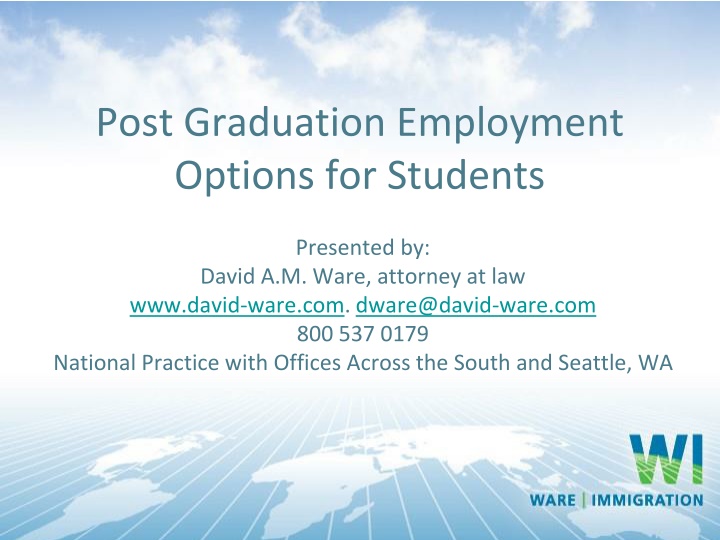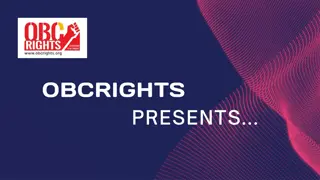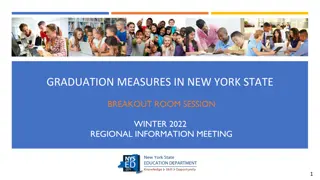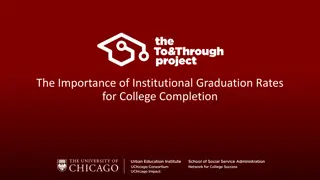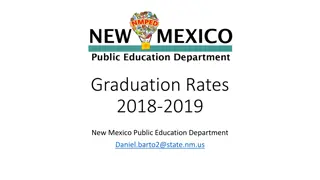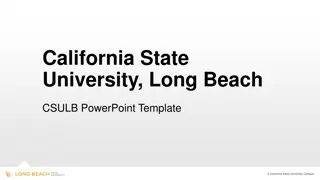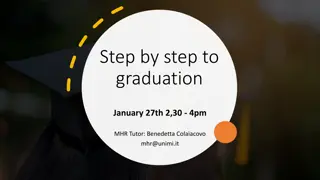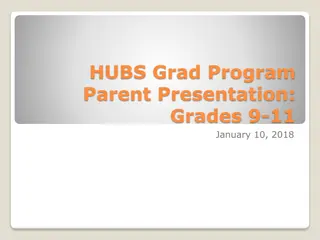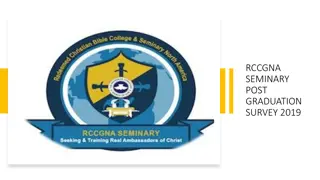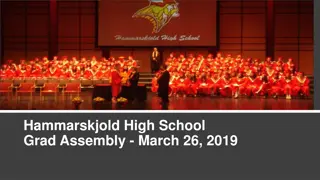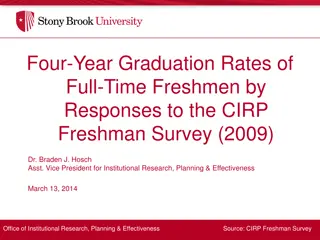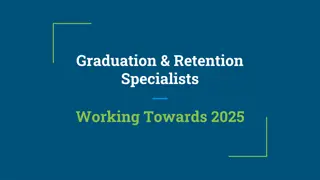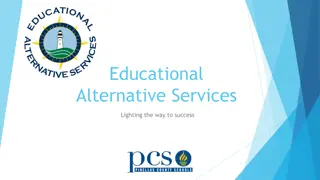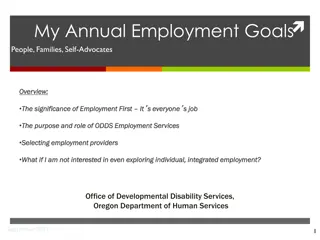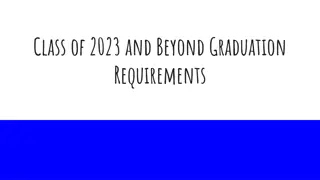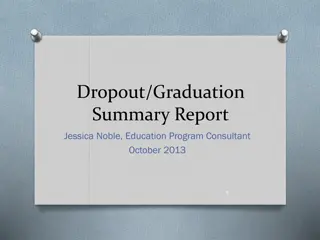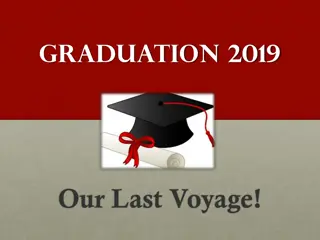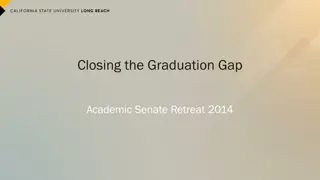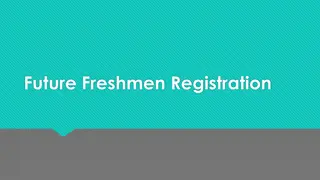Post-Graduation Employment Options for Students
Explore post-graduation employment options for students in the US, presented by David A. M. Ware, an experienced immigration attorney. Learn about steps to take after completing your degree, the importance of Optional Practical Training (OPT), and considerations for H1B visas and permanent residence. Gain valuable insights for starting your career in the US successfully.
Download Presentation

Please find below an Image/Link to download the presentation.
The content on the website is provided AS IS for your information and personal use only. It may not be sold, licensed, or shared on other websites without obtaining consent from the author.If you encounter any issues during the download, it is possible that the publisher has removed the file from their server.
You are allowed to download the files provided on this website for personal or commercial use, subject to the condition that they are used lawfully. All files are the property of their respective owners.
The content on the website is provided AS IS for your information and personal use only. It may not be sold, licensed, or shared on other websites without obtaining consent from the author.
E N D
Presentation Transcript
Post Graduation Employment Options for Students Presented by: David A.M. Ware, attorney at law www.david-ware.com. dware@david-ware.com 800 537 0179 National Practice with Offices Across the South and Seattle, WA
General Matters WARNING: This presentation provides general information only and cannot substitute for individualized legal advice about your particular case. In the world of immigration, very small factual differences can make a huge difference in your case. In order to receive such advice consult our firm individually or seek a qualified immigration attorney of your choice.
General Matters DON T get advice from friends or relatives. ONLY get advice from your international office or a qualified, experienced immigration attorney. NEVER consult a non attorney who does not work in the international office for immigration advice (including your academic advisor or a notario). ALWAYS follow the advice of your international office.
These Should Be Your Steps 1. Complete degree, in field in demand in US (talk to Career Services early and often!). 2. Don t miss out on OPT! 3. Get good job with good company. 4. Get work visa (usually H1B). 5. Company sponsors for green card.
Where Do I Start? Your career in the US after graduation should ALWAYS start with Optional Practical Training (OPT). OPT ideally acts as a bridge between your studies and the workplace. It allows you to get your foot in the door with a US employer without any paperwork on their part: vitally important. It allows you to try more than one job if you wish.
Can I Skip A Step? While in some cases it may be possible to proceed directly to H1B or even permanent residence without OPT, this is usually unadvisable, as the H1B could be denied, and permanent residence almost always takes more than one year. In cases where you have no OPT available, you have been in H status during the prior six years or are offered a quota exempt job, or are offered a job in the middle of school year, going directly to H could be an option, but only after very careful consideration of strategy and options.
Cross The Bridge You must apply within the 90 days before completing your program or up to 60 days after completion. Apply early and follow school s instructions: all OPT must end within 14 months of program end date. Thus if you apply after completion, you may get less than one year OPT!
How Do I Cross? Eligible for one year of OPT for each higher degree Don t need job offer to apply Employment must be directly related to major field of study. Note: Immigration looks closely at this! Apply by filing Form I-765 with USCIS with OPT I 20 Apply no more than 30 days after school authorizes in SEVIS
New STEM OPT Rule Allows for possible two 24 month STEM extensions, second based on higher degree. Allows for STEM extension based on prior STEM degree, not current degree program. Requires training plan (Form 983) signed by both student and employer; periodic evaluation by employer. Payment of competitive wage. If on 17 month STEM, must apply for seven months with more than 150 days OPT remaining. So, if OPT ended before October 7, you get no more months.
While On OPT.. While engaged in OPT, you must report change of your name, address, or e-mail address, change of employer s name or address, loss of job, and changes of employer to your advisor. Failure to do so could result in denial of future immigration benefits. SEVIS record automatically terminates if no employment information is reported for 90 days.
The Bridge Stops Here Unemployment may lead to violation of status Allowed 90 days unemployment during initial period of OPT, 150 overall during 12 mos + STEM SEVP says paid or unpaid employment of at least 20 hours per week suffices (but not on STEM) and may be with more than one employer. Volunteer! SEVP says self-employment, independent contractor work, or through agency or consulting firm are acceptable (but not on STEM). No grace period between jobs. Time outside U.S. does not count as unemployment if you are employed before leaving U.S. and are authorized by your employer to be abroad.
The Next Step: H1B H1B is the principal immigration status available for persons temporarily working in professional level jobs ( specialty occupations ) in the US. Who sponsors? www.immihelp.com/hib- sponsoring-companies-database/; www.myvisajobs.com It generally requires that the employee have at least a four year degree or equivalent AND that the position require a minimum of a bachelor s degree. So, for example, engineer, accountant, yes; store clerk, cook, secretary, no.
What Are the Limitations of H1B? Employment is limited to the employer(s) who petition(s) for the student. May hold more than one H1B at same time. H1B may be part time. Employment is generally limited to six years with ALL employers (unless employment-based permanent residence begun by end of 5thyear). Employment must be directly related to degree program either current program or any prior degree program. H1B s are limited by strict fiscal year quotas. Federal FY = 10/1 to 9/30 each year. The H1B beneficiary may have dual intent .
What Are the Employers Obligations? Must agree to employ beneficiary as set out in the petition (no fraud). Must need the services of the employee (no uncles with corner stores). Must agree to employ H1B only in geographic location(s) set out in labor condition application. Must offer to pay return transportation to country of nationality if H1B terminated before end of visa petition approval.
Employers Wage Obligation Must agree to pay higher of actual or prevailing wage (aka required wage ). Actual wage: wage paid to other similarly employed and similarly qualified workers at same worksite. Prevailing wage: weighted mean or median wages for similar positions in geographic area of employment. Basically, this means that a competitive wage must be offered. There are four levels of wages and separate wage data for higher ed and certain other employers. See: www.flcdatacenter.com/oeswizardstart.aspx
Employers Obligations? Must be no strike or lockout (unionized jobs). Must notify other workers of terms of job (two 10 day postings or letter to union). Must agree to pay certain fees to USCIS (next slide).
What Are the Fees? Regular filing fee: $325 Anti fraud fee: $500 ACWIA fee: $1500 (if 26 more FT employees) or $750 (if 25 or fewer) Filing fee for dependents: $290 Premium fee: $1225 15 day processing Attorney s fees: vary widely: no standard amount.
Who Pays for What? Except for ACWIA fee, which the employer MUST pay, until recently, there was no hard and fast rule. A series of judicial decisions now makes clear that the employer must pay all costs and fees required to get the employee on the payroll. Employer could incur huge liabilities if they don t pay. What to do if they don t want to pay? Have them discuss issue with experienced immigration attorney. Note: employer not responsible for dependants.
Whats Filed and When? First is Labor Condition Application (LCA). Filed electronically with Department of Labor. Takes about five to ten business days to be approved. Next is H1B Petition, together with LCA, evidence of qualifications, and description of job, filed at either Vermont or California Service Center of USCIS, depending on place of employment, or California if quota exempt. If employee maintaining lawful status in US, status is changed to H1B, along with family members. If outside US, or traveling following change of status, must obtain H1B visa at US consulate, unless going for 30 days or less to Canada/Mexico.
The Magic Approval Processing of the H generally takes three to seven months. Fifteen day premium processing is available for $1,225; PP also guarantees easier communication with USCIS via phone/email. Once approved, the H employee may port to a new employer once that employer files a new petition. Approval of new petition is not necessary to port . BEWARE: porting is difficult if you have not been counted against the quota.
The Cursed Quota How many H visas are made available per year? Currently H1B s are limited to about 78,200 per fiscal year. ~58,200 for those with no US earned Master s. --20,000 for those with US earned Master s or higher. ~6,800 reserved for H1B1 for citizens of Chile, Singapore.
Quota Statistics 2012: Masters, June 7; regular June 11. 2013: both caps exhausted on April 5; lottery. 2014: both caps exhausted on April 7; lottery. 2015: both caps exhausted on April 7; lottery. 2016: both caps exhausted on April 7; lottery. 236K + petitions received. So, in other words, it is likely there will be a lottery for H visas every year. Extremely important not to miss even one H cycle, even if on STEM extension. Stay on top of this!!
Whos Exempt from Quota? Exempt from the quota are Persons already counted against it within past six years. persons who work in higher education and affiliated nonprofit entities. Those who work at rather than for a quota exempt employer, that is on physical premises of employer Employees of non profit research and government research organizations. Note that most government entities and non profits are NOT exempt from quota. J 1 physicians granted a waiver of the two year home residence requirement to work in underserved area. Persons engaged in concurrent quota exempt/quota subject jobs, that is working simultaneously for quota exempt and quota subject employers.
So Called cap gap OPT In April, 2008, in order to assist students caught by the H1B quota, USCIS created so called cap gap protection which automatically extends OPT and DS through September 30 of any year, if: The student s employer properly filed an H1B petition on his/her behalf prior to the expiration of his/her OPT (which must end on or after April 1); The H1B petition is subject to the quota and shows a start date of October 1. Cap gap OPT ends midnight September 30. -- If the H petition is filed during the student s grace period, after expiration of OPT, then the cap gap extends status only, but not work authorization. In order to fully document the cap gap , the student should seek a cap gap I 20 from his/her school.
Travel While In Cap Gap You should not travel while in the cap gap as you will have no valid EAD card. Reentry to the US on OPT generally requires: I 20 endorsed for travel Valid passport and F 1 visa (unless visa exempt) Valid EAD card Employment letter
Cap Gap Example Maria s OPT will expire May 15, 2016. Her employer will file an H petition for her on April 1, 2016, with a start date of October 1, 2016 (the earliest date that can be requested). The H is pending, but not approved, until, September 15 (it MUST be adjudicated by September 30). Maria s F status and OPT will automatically be extended to midnight, September 30, 2016. She may (but does not have to) request a cap gap I 20 from her school. What if Maria s OPT ends on March 15 and employer filed on April 1?
When Looking for a Job, Beware Many beginning positions in business do not require a degree: eg, sales, management trainee slots. See next slide. Many entry level jobs pay partly or solely on commission. Commission or sales bonuses generally cannot be included in the wage computation. Beware of make work or make believe jobs from friends or relatives. Pay stubs, W 2 s will be required when you go abroad for visa issuance, apply for future immigration benefits! Also beware of fly-by-night companies which may bench you until they place you in a job. Paying a company to file for you when you have no intention of working for them is FRAUD can jeopardize your future in the US. Startups, financially troubled businesses, and those that take a tax loss each year will NOT be able to sponsor for permanent residence!
Does This Job Require a Degree? Complexity of job:Does the job require the application of theoretical and practical knowledge typically acquired in a relevant four year degree program? Employer reqts: Has the employer consistently required a minimum of a Bachelor s in particular major(s) for position? Or is the requirement simply an employer preference? Or is the employer simply making up the requirement to get you an H1B? Other, similar: What are industry standards for this type of job? Check ads on internet, DOL s Occupational Outlook Handbook. $$$$: Is the salary commensurate with a professional-level position?
Employers H1B Misconceptions Employer believes that it must recruit, prove American workers not available, or prove that student is exceptional, special, or unique in order to sponsor. FALSE: No recruitment required. Special qualities not required. Two ten day postings or letter to union are for notification only.
MisconceptionsTrouble, Money Employer thinks the process will get them in trouble with immigration . FALSE! Employer doesn t fears revealing financial info to USCIS. FALSE! Very little info needed; can be kept confidential; USCIS does not enforce tax laws.
Misconceptions--Paperwork, Salary Employer thinks it s too much trouble, paperwork . FALSE! Employer doesn t want to post wage for all to see. POST A RANGE. Employer thinks H can be skipped, go directly to PR. FALSE! PR can take a long time.
MisconceptionsContract? Employer worries that sponsorship may constitute contract of employment. FALSE! Employer worries that employee is later going to ask for PR and leave the company they ve been burned before (Sign a one way contract; employee has to repay legal fees if leaves before a certain date; but employer retains right to employ at will ).
What About Starting My Own Business and H? To be an H1B employer, an entity usually must have at least one employee other than the H1B and must have a Board that can fire the H1B. Very difficult to get a self employed H petition approved (despite Obama s promises). Also, difficult for new company to pay required wage. Usually not a wise idea to start your own business, unless you have loads of money (at least 500K to 1 million) or qualify for investor visa (treaty required we will discuss later). Why not? Generally, business owners cannot sponsor themselves for permanent residence. Consider E, O or L instead of H (see below). Resource: http://www.uscis.gov/eir/visa- guide/entrepreneur-visa-guide
Are There Alternatives to the H? TN (Treaty NAFTA) for citizens of Canada and Mexico only. Occupations listed at 8 Code of Federal Regulations Sec. 214.6(c) mostly require a minimum of Bachelor s degree, except Scientific Technician/Technologist. But MBA s beware: Management Consultant is carefully scrutinized; generally must be independent contractor. TN given in three year increments; requires residence abroad (no dual intent).
Other Alternatives? H1B1 visa for Chile, Singapore: very similar to normal H1B, except granted in one year increments, requires residence abroad (no dual intent). E 3 for Australian citizens; again very similar to H1B; two year increments; minimum Bachelor s, dual intent ok; spouses may work. H-3 trainee. 2 yrs max; training must be for job abroad. J-1 trainee. 18 mo. max; looser than H 3, but some J sponsors will not sponsor if you are in US. Also must have degree and one year experience from abroad. J-1 professor/researcher, specialist , short term scholar, K-12 teacher, camp counselor, summer work-travel.
Alternatives? O-1 person of extraordinary ability/achievement. E 1/E 2: if your country of nationality has an trader/investor treaty with US, investment of as little as 50K in a job-creating business can mean a visa for life, work permit for spouse. See if your country is covered: http://travel.state.gov/content/visas/english/fees/treaty.html L 1A/L 1B: if you were employed by a company abroad for at least a year before coming to the US, and they wish to employ you in US; work permit for spouse. R-1: possible if job offer has a significant religious component. B-1 business visitor: only possible if employed outside US, no remuneration in US except expenses, and product/service is made/rendered outside US. Sometimes used in lieu of H1B and H3 traineee if based and paid outside US. VERY LIMITED UTILITY.
Other Work AlternativesDACA DACA = Deferred Action for Childhood Arrivals. Established by the President June 2013. Must have arrived in the US under the age of 16. Must have entered by June 15, 2007. Must have entered without inspection or lawful period of stay must have expired by June 15, 2012. Must have been resident in the US since that time, physically present on June 15, 2012 and at time of application. Must have no serious criminal record felony, significant misdemeanor, or three other misdemeanors, not a threat.
Temporary Protected Status-TPS Permission to remain and work in the US for citizens of countries under severe stress. Currently, citizens of the following countries enjoy TPS: Yemen, Haiti, Nepal, Somalia, El Salvador, Syria, Guinea, Sierra Leone, Liberia, Honduras, Nicaragua, Sudan, South Sudan. To qualify, must have arrived in the US by a given date, and apply by the deadline.
What If No Job Offer in US? Go back to school, retool your skills to fit the market. Canada, Australia or other country with demand for your skills are alternatives. Canada has an easy point system. See cic.gc.ca. Your home country or other country where your language is spoken/your skills are in demand. Many companies, eg, Johnson and Johnson, eagerly hire for home country service, and then often transfer back to the US.
What is Permanent Residence? The right to live and work permanently in the US for any employer. A person becomes a permanent resident through adjustment of status in the US or issuance of an immigrant visa outside the US. A person generally must maintain lawful status in order to adjust in the US. What can jeopardize permanent residence? Any absence of over six months from the US; Abandonment of residence in the US; Certain types of criminal conduct. Permanent residence is usually represented by a plastic card issued by USCIS. Permanent residence is not citizenship: that comes usually after a period of permanent residence.
Routes to Permanent Residence Employment-based Family-based U.S. citizen or permanent resident spouse USC or PR parent; USC child over 21; USC sibling Long waits for all but spouse of USC or parent of USC child over 21. Asylum Large Investment Domestic Abuse Victims of Human Trafficking and Serious Crimes Private Bills very rare MAVNI, Military Accessions Vital to the National Interest. See http://www.defense.gov/news/mavni-fact-sheet.pdf Removal Proceedings Diversity Visa Lottery: only apply at www.travel.state.gov.
Countries of Birth NOT eligible for last lottery, unless spouse born elsewhere: BANGLADESH, BRAZIL, CANADA, CHINA (mainland-born), COLOMBIA, DOMINICAN REPUBLIC, ECUADOR, EL SALVADOR, HAITI, INDIA, JAMAICA, MEXICO, NIGERIA, PAKISTAN, PERU, PHILIPPINES, SOUTH KOREA, UNITED KINGDOM (except Northern Ireland) and its dependent territories, and VIETNAM.
Employment Based Immigration Generally must have full time permanent job offer. Only exceptions, National Interest Waiver, Alien of Extraordinary Ability. First step is generally labor certification (LC). Only NIW, Extraordinary Ability, Outstanding Professor/Researcher, Aliens of Exceptional Ability, Nurses, PT s can avoid LC.
Are you exempt from LC? National Interest Waiver: activity must be in national interest, affect whole country, applicant must have some achievements; may self sponsor. Extraordinary ability: Must have risen to very top of field of endeavor ; may self sponsor. Outstanding Professor/Researcher: must have tenure track or permanent job offer; three years experience, be of international renown .
General Steps in EB PR Labor Certification + Employer Petition + Adjustment of Status, OR If exempt from Labor Certification = Employer Petition + Adjustment of Status
Employment-Based PR--Steps 1. Labor certification Employer advertises position to test the labor market Several forms of advertisement required Employer files application through PERM system (online) DOL approves, denies, or audits Employer must pay attorney s fees and ad costs. 2. Immigrant petition (I-140) with USCIS 3. Adjustment of Status Application (I-485) with USCIS Must have current priority date on Visa Bulletin to file Some categories/countries backlogged, queues of several years If current, may file petition and application together ( concurrent filing ) Can apply for EAD and advance parole travel document with adjustment application Spouse and unmarried minor children can file AOS at same time. Can cross charge to place of spouse s birth. 4. During entire process employee must maintain valid nonimmigrant status.
Who Has to Wait Certain persons are subject to waiting lists and cannot file for adjustment of status until at the top of the waiting list: Persons born in India or China, unless spouse born in another country. Persons whose position requires less than a Master s degree OR a Bachelor s plus five years experience (EB 3).
Permanent Residence Myths There is no such thing as sponsorship for permanent residence by a friend, someone with connections , or distant relative. Congressmen can help with PR only by sponsoring a private bill in the most extreme situations where no legal remedy exists. Very rare! Otherwise, only can help if case stuck . Other influential community members generally cannot help. Adoption does not confer immigration benefit unless completed while under age 16.
Permanent Residence Myths The mere accrual of time spent in the US generally does not make one eligible for PR. Sponsorship by an employer or most family members does not generally result in an automatic right to remain in the US while sponsorship is ongoing; person must have independent nonimmigrant status, eg, F 1, H1B. Hardship, standing alone, is not a basis for PR. Country of origin is largely irrelevant in PR process.
